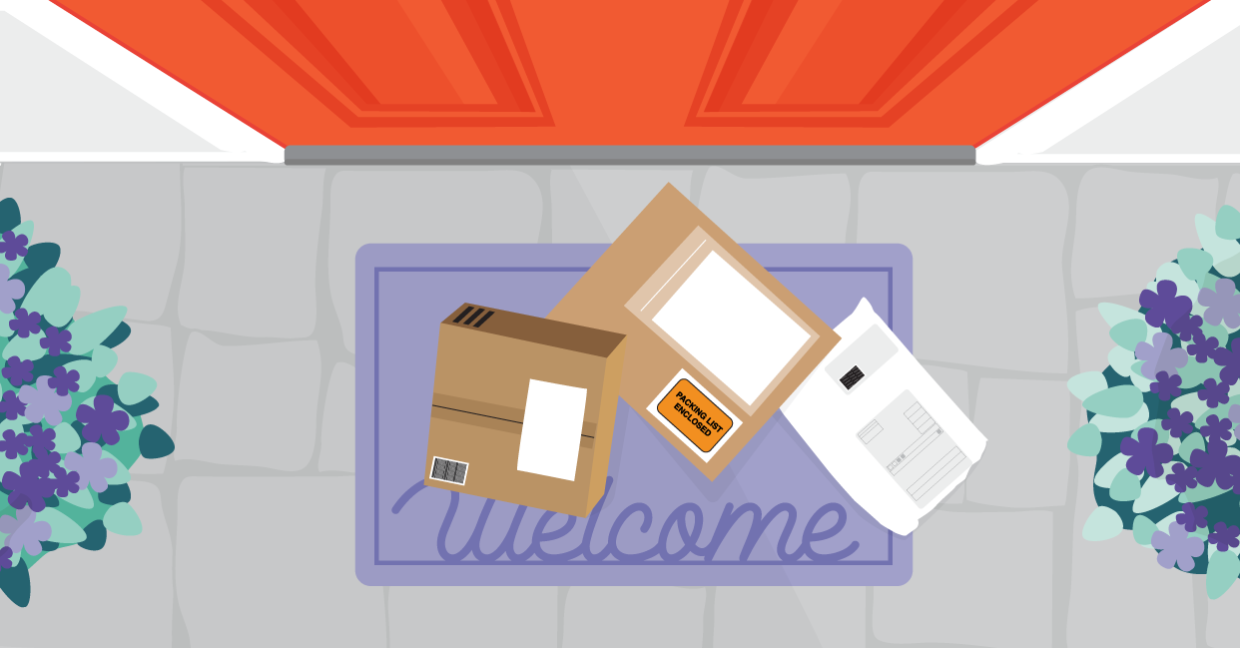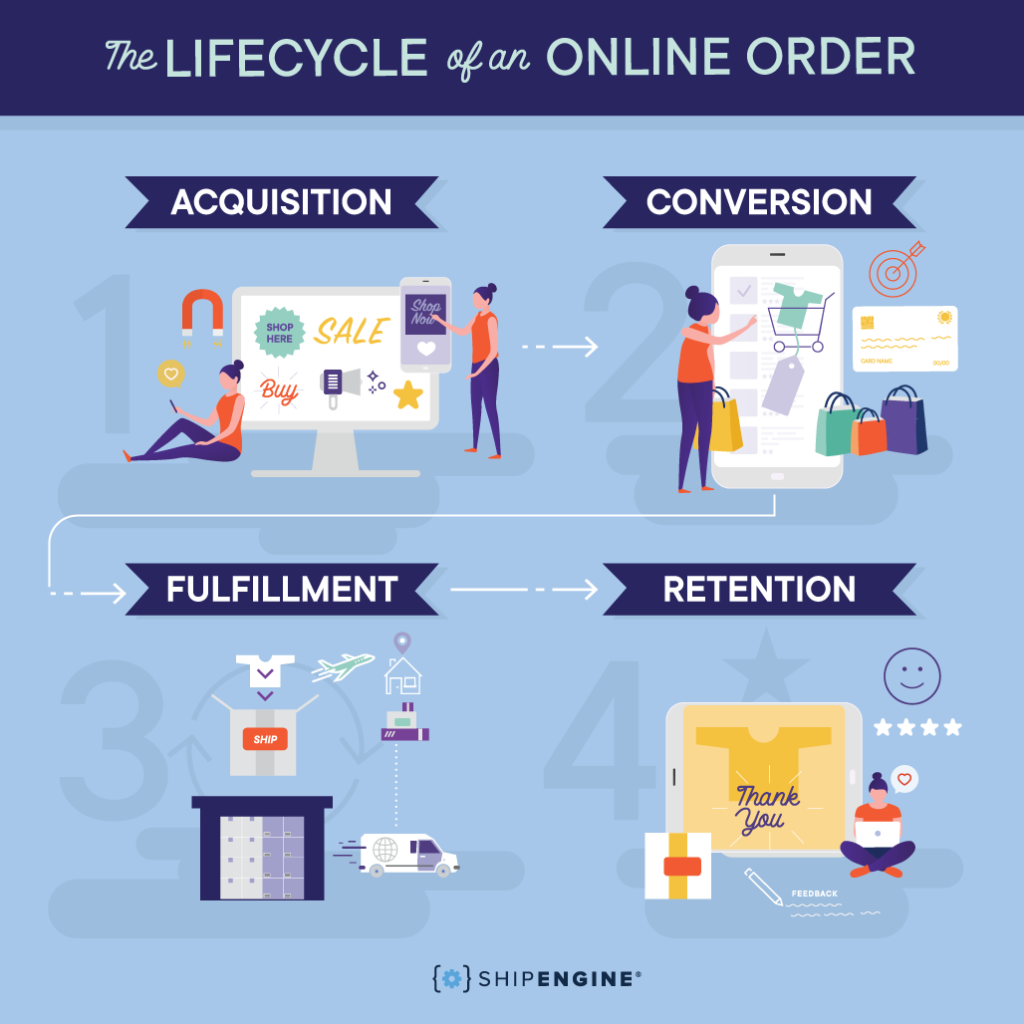
A satisfying ecommerce experience is like magic to your customer. All it takes is a few mouse clicks plus a form completion — and then a parcel shows up in the mailbox or on the doorstep.
But not all ecommerce experiences are satisfying. The postage might be too expensive, delivery might take too long, or returns might be overly complicated.
Creating satisfying experiences means perfecting each stage of the lifecycle of an order. Perfecting this process can ultimately make the difference between success and failure for your business. Here’s a look at the four stages of the lifecycle — plus how you can master each stage in a way that allows your business to grow.

1. Acquisition
The bigger your audience, the more ecommerce products you’ll be able to sell. But how do you attract an audience to your online store? There’s no tried-and-true template for all brands. The right marketing mix for your business will depend on the nature of your products and the types of customers you’re targeting. There are limitless channels you can consider, including:
- Ads: You can run pay-per-click (PPC) search ads through Google, Bing and other search engines. PPC ads let you identify keywords relevant to your products and serve ads to prospects searching those phrases. You only pay if the prospect clicks your ad, hence the name “pay-per-click.” You can also run social media and display ads to develop brand awareness and drive more traffic to your site.
- Retargeting: Have you ever seen online ads for a site that you visited hours earlier, a day before or even a week ago? You’re being retargeted. Retargeted ads give you the power to put your brand message in front of a past visitor so that you can try again to nudge them toward a purchase.
- Organic Search: Do you have a content plan in place? Just like you can use PPC ads to target certain search terms, you can do the same thing by creating rich content with those same terms strategically embedded. Generating organic traffic takes time, but it delivers a huge return if you can rank for the right phrases.
- Email: Nothing converts quite like email marketing. Developing a significant email list gives you a captive audience to which you can send special offers and other marketing materials.
- Partnerships: Consider partnerships with suppliers, vendors and brands that might serve your same target audience (without directly competing against you). You can often find mutually beneficial ways to co-market to your shared target audience.
What you see above is just a sample of the many ways you can acquire prospective customers. Find the right blend of marketing channels for your brand, and then measure and tweak performance for increased sales.
2. Conversion
Getting visitors onto your site is just half the battle. Once they visit your store, how do you get them to actually buy something?
The foundation of a high-converting site is quality design and a thoughtful user experience. Spend time, energy, and effort perfecting the look, feel, and navigation of your site, and inching your visitors toward conversion will be that much easier down the road.
Once you have a well-designed site with the right user experience, make visitors a tempting offer. Highlight seasonal specials on common landing pages. You can also offer a limited-time coupon to create a sense of urgency and make your visitors feel like they’re getting a great deal.
Once your visitor places items in his or her shopping cart, recommend other items. Did a visitor put shorts in the cart? Recommend a matching top. Did a visitor put a duvet cover in the cart? Recommend a new duvet. You can also offer add-on products at checkout — giving visitors a chance to add a related item at a heavily discounted price right before entering credit card information.
And don’t forget about shipping. Amazon has conditioned today’s ecommerce customers to expect fast, inexpensive shipping options. Using a shipping API like ShipEngine lets you shop discounted rates across multiple carriers and create rules to serve customers the fastest or least expensive option — or to give customers multiple shipping options to choose from.
3. Fulfillment
Once your customer places an order, the hard work starts. Anyone who’s successfully launched an ecommerce business knows the complexities of picking items, packing them, printing labels, shipping orders, etc. It can be time-consuming and overwhelming if you don’t have the right workflows in place.
Thankfully, shipping technologies like ShipEngine exist to help you master fulfillment. When you integrate with ShipEngine, you can auto-generate labels in whatever file format works best for you. You can also print pay-on-use return labels that make returns simple. ShipEngine also offers comprehensive documentation and helpful error codes to help you get up and running quickly.
While your customers are generally unaware of your fulfillment processes, they are highly impacted by the results. When you establish automated shipping workflows, your team can quickly and easily fulfill orders, creating a quality ecommerce experience for your customers.
4. Retention
Now comes the fun part: turning your first-time buyers into regular customers that drive more and more revenue. When you create a delightful customer experience, you get people coming back for more again and again. Here are common ways to boost your retention:
- Offer fast, inexpensive shipping
- Make returns incredibly easy
- Use address validation to ensure your parcels reach their destinations
- Provide insurance that protects both buyer and seller
- Follow up with thank you emails that include coupons and/or feedback forms
In short, make sure your customer leaves the ecommerce transaction feeling good about doing business with you. If you can offer a quality product that reaches the buyer reliably, quickly and inexpensively, you’ll be top of mind when the time comes for another purchase.
Perfect Your Shipping Workflow — Try ShipEngine Today
At ShipEngine, we provide a shipping API that helps users perfect the lifecycle of an order. The features and tools available through a ShipEngine integration help you across the last three stages of the lifecycle: conversion, fulfillment and retention.
Is your ecommerce business maximizing its potential? Get a free ShipEngine API key and start exploring how our shipping API can help.


Leave a Reply